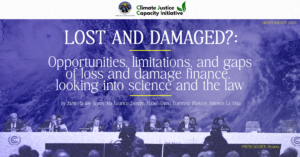
Abstract:
More than three decades since first proposed by Pacific Island states, loss and damage finally became part of the international climate negotiations. During the Conference of Parties 27 (COP27) in Sharm el-Sheikh in Egypt, country Parties agreed not only to include loss and damage in the agenda, but also decided to establish a Loss and Damage Fund. Further, a Transitional Committee was established to draw recommendations on how to operationalize the LDF for consideration and adoption by the Conference of Parties at its twenty-eight session which will take place in Dubai at the end of 2023.
With loss and damage officially taking up space in the climate negotiations, questions now abound on how to translate loss and damage not just into actionable international policies, compatible both within the United Nations Framework Convention on Climate Change (UNFCCC) and the Paris Agreement processes and outside of it, but as well as into local, national, and regional climate actions.
This paper, therefore, will historicize loss and damage as well as the mechanisms related to it in the years leading up to COP27, look at the science and laws that relate to loss and damage, including currently existing loss and damage financing regimes, all with the eventual goal of laying down solutions to operationalize and implement loss and damage on the ground, taking the Philippine experience as a jumping point.
This paper is produced as part of the Climate Justice Capacity Initiative (CJCI) through the generous support of FILE and ClientEarth.
Download here:
MO_CJCI_Lost and Damaged Opportunities, limitations, and gaps of loss and damage finance, looking into science and the law
